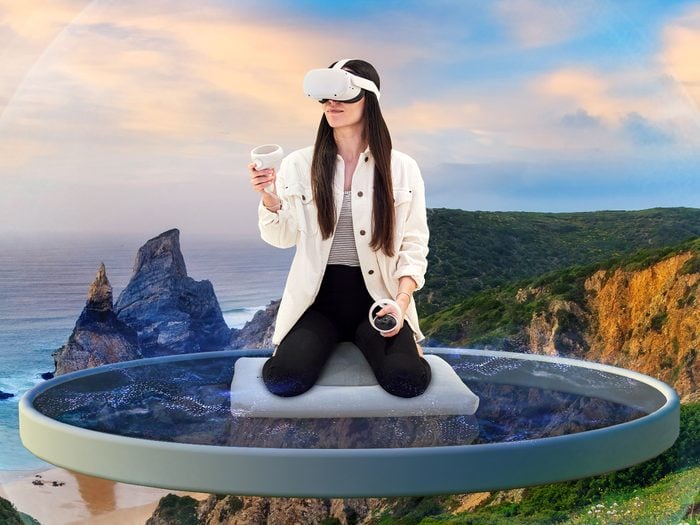We Tried Meditating in the Metaverse

We tried a guided meditation VR app to see if it could really transport us to a more mindful place.
What if you could meditate on a beach? Or in front of a glowing orb? Or while floating in space? This is all possible with guided meditation VR.
In 2018, when Toronto-based meditation studio Hoame was playing with the idea of a virtual reality (VR) experience, the Metaverse didn’t exist. But Stephanie Kersta and Carolyn Plater, the two mental health experts behind the app and IRL studio, were already working on demos. From their experiences as clinicians, they knew that immersion is a remarkably useful tool in psychotherapy, though it can be difficult to achieve in a clinic.
Exposure therapy, for example, can help those suffering from PTSD or who have severe phobias. “If someone has a phobia of, say, spiders, it’s hard to, well, bring in spiders to the office,” says Kersta. “But, if you can go onto a headset and see spiders and work through the fear, it’s safer and much more controlled environment.”
VR can also bring meditation and mindfulness to those who are restricted in their settings. Plater points to seniors in long term care homes who are under lockdowns, and people in hospitals or in correctional facilities who can’t physically leave to go to an in-person meditation class.
Unfortunately, Hoame’s app is only available on VR headsets made and operated by Meta (formerly known as Facebook). While most people have a smartphone, not many people have a headset at home. And they can be pricey: The Meta Quest 2, their latest product, costs $610.
(If you’re feeling confused–don’t worry, we were, too!—here’s a breakdown: Meta owns the brand Oculus, which makes Quest headsets. Because Hoame only lives on the Meta “app store,” you can only get the Hoame app on Meta-produced headsets like Oculus and Quest.)
I found that depending on your facial anatomy and headset fit, the gear required can also impede or distract from your experience. I had a chance to try Hoame’s VR meditation app recently and I couldn’t get past the feeling of the heavy headset on my cheekbones and face, which definitely made it a bit harder to focus on my breath.
Other than the slight discomfort of the headset itself, Hoame’s app was immersive and easy-to-use. Once you’re strapped into the headset with the app loaded, you feel as if you’re inside Hoame’s actual meditation studio. There’s even a customizable image of a pillow and mat placed under you. In-app, it looks like you and the instructor are doing a class together.
Then, once the class starts, your background imagery varies, depending on which theme you choose, but you always feel like you’re suspended in air. In one, I was floating above a rocky beach during sunset, meditating while the waves rolled in. In another, I was drifting through space, as stars floated past me placidly. It’s also a 360-degree experience, visually: I really enjoyed looking behind me and feeling like I’d been transported.
Some people report motion sickness while using VR, but I didn’t experience any of this—though the visuals I was seeing inside my headset weren’t moving as much as they would if I were, say, playing an active video game.
For both the on-demand pre-recorded classes and the live classes, Hoame prompts users to input their pre-meditation mood, picking between six options (happiness or anxiety, for example). After class, the app prompts you to check in on how you’re feeling again. By the time the meditation was over, I was feeling more relaxed, and rated my anxiety lower than it was when I started meditating.
Hoame does offer different meditation types, like sound bathing and sleep meditation, depending on your goals. Classes generally consist of you and the instructor sitting in a beautiful space while they instruct you to breathe, let go of your thoughts and tune out anything happening outside of the class. In this way, Hoame’s VR app was very similar to apps like Calm and Headspace. The app also has a breathwork trainer, where a floating orb helps you count through breaths. There are several different breathing styles that you can practice, such as vagal breathing (breathing in through the nose and having your belly expand, then breathing out through the mouth and relaxing your belly), or square breathing (which is when you do cycles of breathing in for four seconds, hold for four, out for four, hold for four and repeat).
Despite the strange fit of the headset (at least for me), Hoame’s app builds on all the good parts of virtual meditating—it brings mindfulness into the home and can help users in a convenient, safe environment. It’s not cheap, but it is really calming to hear the gentle music play, stare out into a gorgeous vista and bring your focus to yourself, no matter where you are.
Hoame, free 7-day trial and then $10/month
Next: My Phone Makes Me Deeply Anxious, Can a Meditation App Help?




